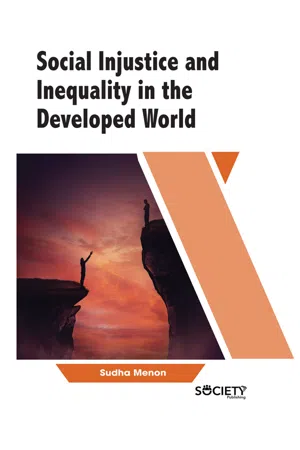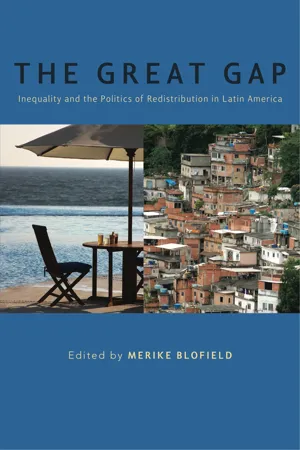Geography
Equity and Inequality
Equity refers to fairness and justice in the distribution of resources and opportunities, while inequality refers to disparities in these distributions. In geography, equity and inequality are studied in relation to access to resources, land use, and socio-economic conditions within and between different regions. Understanding these concepts helps geographers analyze spatial patterns of development and identify areas in need of intervention.
Written by Perlego with AI-assistance
Related key terms
1 of 5
4 Key excerpts on "Equity and Inequality"
- eBook - PDF
Development Economics
Theory and Practice
- Alain de Janvry, Elisabeth Sadoulet(Authors)
- 2021(Publication Date)
- Routledge(Publisher)
Their interpretation is that genetic diversity undermines trust and cooperation, increases income inequality, and reduces investment in public goods. These regularities are interesting but need to be interpreted with caution, as they strictly rely on cross-sectional associations. If many current development outcomes are shown to have their roots in factors that were determined a very long time ago, as far back as the dawn of humanity, then initial conditions continue to matter. WHAT R OLE FOR E QUITY IN D EVELOPMENT ? The World Development Report 2006 (World Bank, 2005b) addressed the issue of equity and development, an important dimension of development, previously neglected. It is not clear, however, that the policy implications of addressing equity bring in much that was not there before in the pursuit of development. Equity is defined as equality of opportunity for success: it is an ex ante concept relative to outcomes. Equity requires level playing fields so development outcomes for individuals depend only on their levels of effort and on luck, not on particular circumstances such as their initial individual characteristics, asset endowment, and context. The World Development Report 2006 documents the fact that there are massive inequities attached to gender, race, caste, place of birth, parental education, paternal occupation, and parental socioeconomic status. According to Roemer (2013), the traditional utilitarian “equality approach” to development consists of equalizing outcomes such as income, wages, and life expectancy. By contrast, an “equal opportunity approach” to development equalizes outcomes only at equal levels of effort. It requires equalizing the role of circumstances on outcomes at given effort. Alternatively, it requires eliminating inequalities that are due to circumstances for which persons should not be held responsible as they are beyond their control. - Sudha Menon(Author)
- 2020(Publication Date)
- Society Publishing(Publisher)
2.3. INEQUALITY IS THE BIGGEST THREAT TO THE WORLD In present times, anyone can say that increment in the inequality issue has been one of the most influential issues for every part of society. The business delegates also considered inequality one of the influential factors that are affecting the global economy. At the national level, one basic procedure for lessening disparities is to guarantee general access to great quality essential products and enterprises: nourishment, lodging, fundamental enhancements like water and vitality, wellbeing administrations, training, and social assurance. The Copenhagen administrator’s synopsis explanation targets aimed at all-inclusive access to essential administrations and assets. On account of the current structures of separation and rejection, pointers need to follow progress among the most ruined, underestimated, and avoided gatherings. Social Injustice and Inequality in the Developed World 40 Along these lines, notwithstanding an approach of universalism, explicit mediations might be required, and a portion of these was talked about at the gathering: governmental policy regarding minorities in society; directed open interests in underserved territories and parts; access to assets that are not contingent; and cognizant comprehension of how arrangements are executed on the ground concerning the financial, social, lawful, managerial, and social real factors. This prompts the inquiry: where are the assets for such attractive approaches to originate from? Financial approaches were expressly getting looked at, especially charge arrangements that try to improve assortment from parts and operators that have profited lopsidedly from total salary development. Numerous pioneers discussed charge techniques higher assessment rates, yet better and increasingly successful usage of existing expense laws and shutting charge escape clauses.- No longer available |Learn more
World Social Report 2020
Inequality in a Rapidly Changing World
- Department of Economic and Social Affairs(Author)
- 2020(Publication Date)
- United Nations Publications(Publisher)
This growing evidence base has helped ensure consideration of income inequality as part of the international development agenda. This section summarizes what is now a broad and burgeoning technical literature on the topic. Considering that each indicator of economic inequality has strengths and limitations, the analysis uses several indicators to assess progress – or lack thereof. Section B illustrates how access to opportunities and resources continues to depend on group attributes such as ethnicity and race, migrant origin, and socioeconomic and disability status. The focus is on the dynamics of group-based inequality – that is, on whether development is equalizing opportunities among groups or, rather, is leaving some groups behind. Section C discusses why inequality matters, focusing on the effect of high and growing inequality on economic growth, poverty, social mobility and political stability. A. Economic inequality People’s opportunities in life and the future of their children are largely shaped by their income and wealth. Now five years into implementation, the 2030 Agenda has focused the attention of the international community on the predicament of growing economic inequality. Real and sustained progress in addressing it, however, has eluded most countries. The evidence presented in this section shows that economic inequality has been on the rise in most high-income countries over the past 30 years but has declined in several low- and middle-income countries. Where inequality has risen, increases have 8 Target 10.1 is to progressively achieve and sustain income growth of the bottom 40 per cent of the population at a rate higher than the national average by 2030. INEQUALITY IN A RAPIDLY CHANGING WORLD 21 been largely due to the rapid rise in top incomes. Even though economic inequality among countries has declined, it is still more pronounced than that observed within countries. Chances in life continue to depend on the country in which a person is born. - eBook - PDF
The Great Gap
Inequality and the Politics of Redistribution in Latin America
- Merike Blofield(Author)
- 2011(Publication Date)
- Penn State University Press(Publisher)
They argue that two diverse sources of inequality can be identified. One source is related to individuals’ circumstances (i.e., all exogenous factors that are given to them and are generally beyond their control), and the other comes from choices individuals make, given their circumstances. The first source is what has been identified as inequality of opportunities. The authors, drawing on extant data and studies, find that predetermined characteristics account for at least 35 of the total inequality in earnings and 50 of the total inequality in consumption. Inequality in educational achievements and inequality in nu- tritional status of children in the region can also be largely explained by in- equality of opportunity. A comparison with developed countries suggests that although there is some variance, Latin American countries are in gen- eral significantly more opportunity unequal. Both chapters in part 1 point to the importance of inequality of opportuni- ties and to the technical and political barriers to addressing it. Introduction 11 Part 2: Elite Culture, Framing, and Public Opinion Socioeconomic inequalities are deep in Latin America and have a profound impact on inequality of opportunities. Why have they not been politically addressed more forcefully? Social scientists have referred to the “dualist world” (Karl 2000, 153) that wealth and income inequalities in Latin America have created or maintained and the corrosive impact these inequalities have on fostering a sense of “common belonging” (Vilas 1997, 23) and “broad and effective solidarity” (O’Donnell 1998, 55), all essential to the quality of democ- racy. The chapters in part 2 explore several of these claims by examining the relationship between inequality and elite culture, media framing of indi- viduals in different positions of power, and public opinion on inequality and redistribution.
Index pages curate the most relevant extracts from our library of academic textbooks. They’ve been created using an in-house natural language model (NLM), each adding context and meaning to key research topics.



